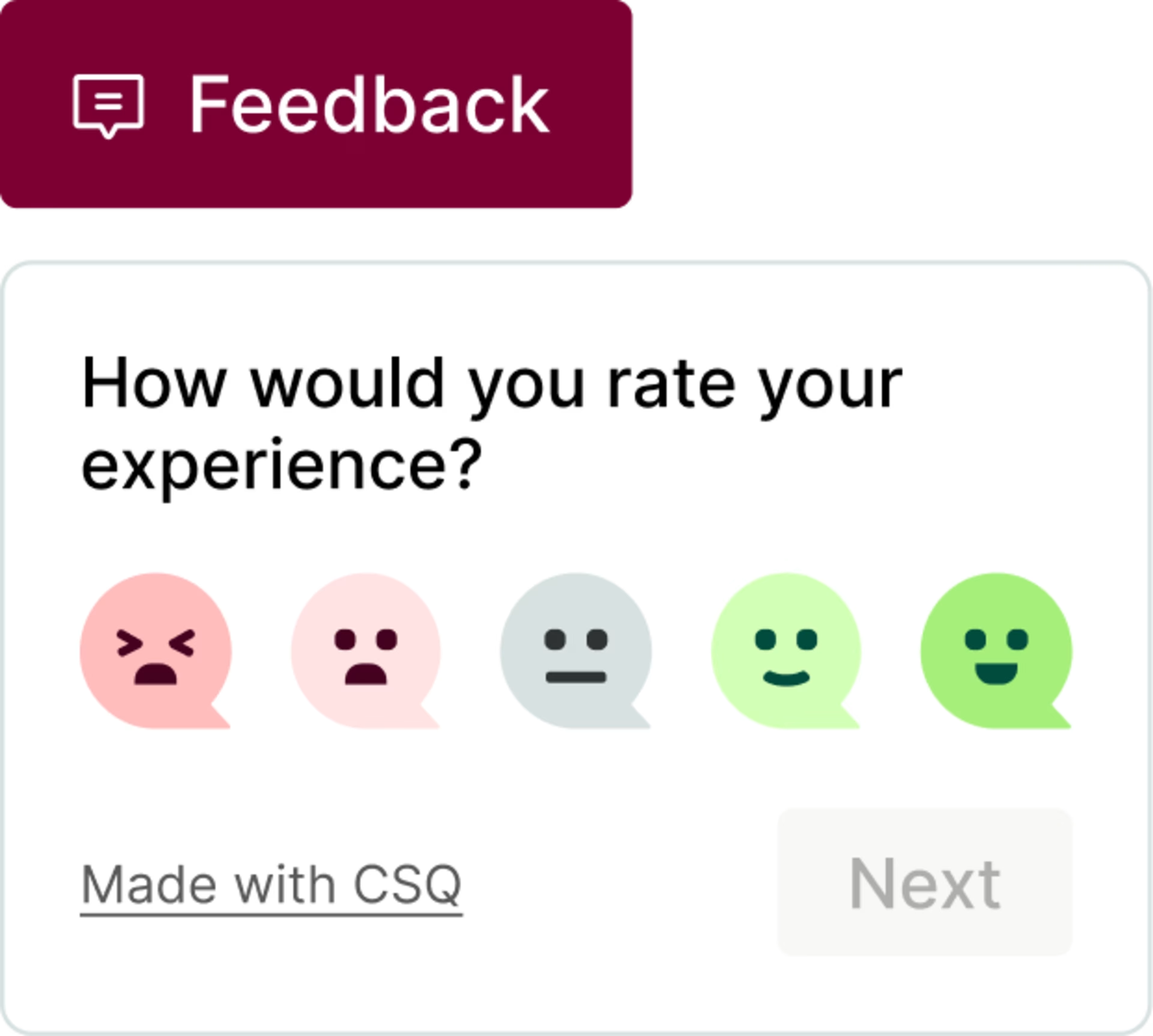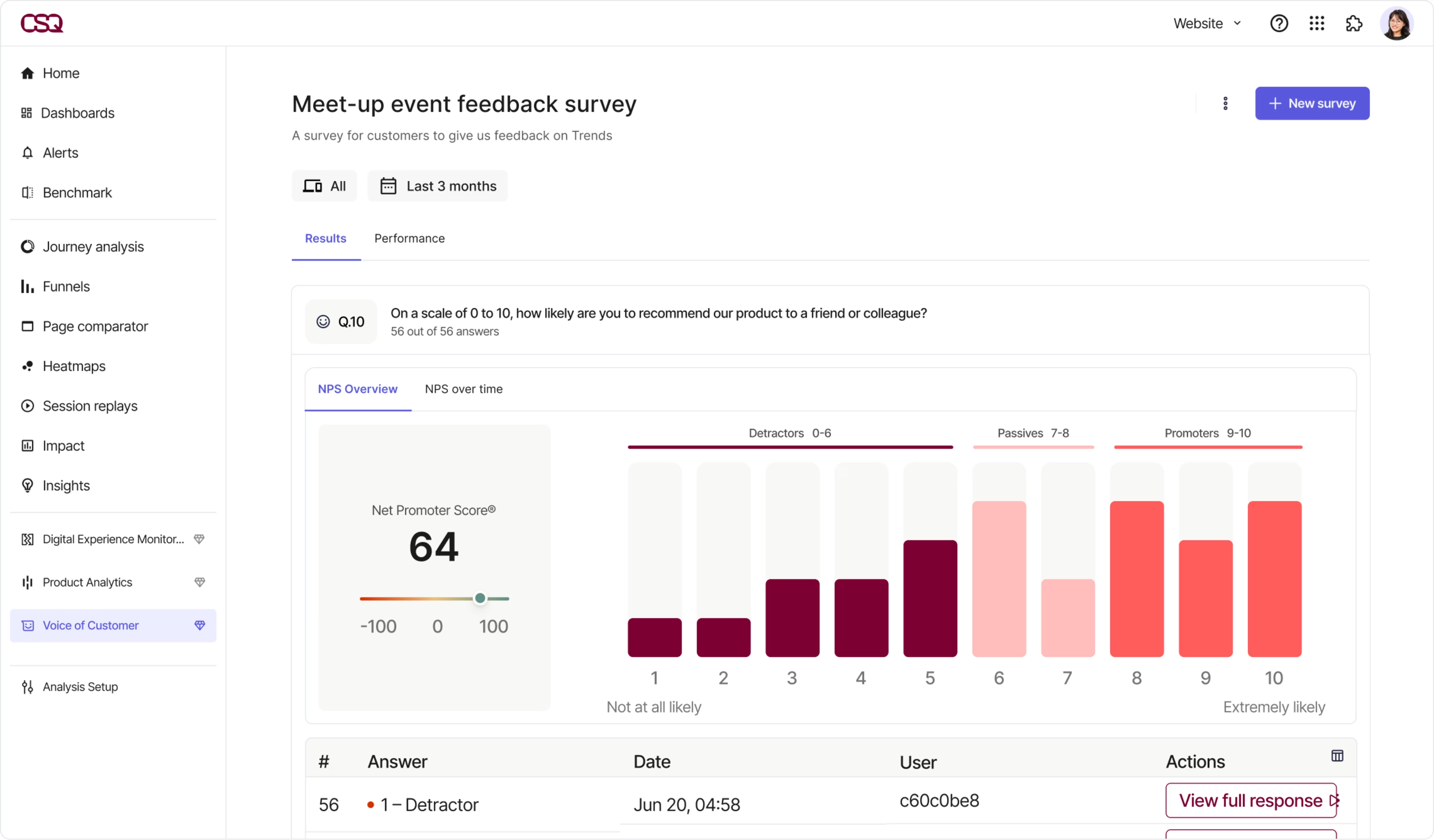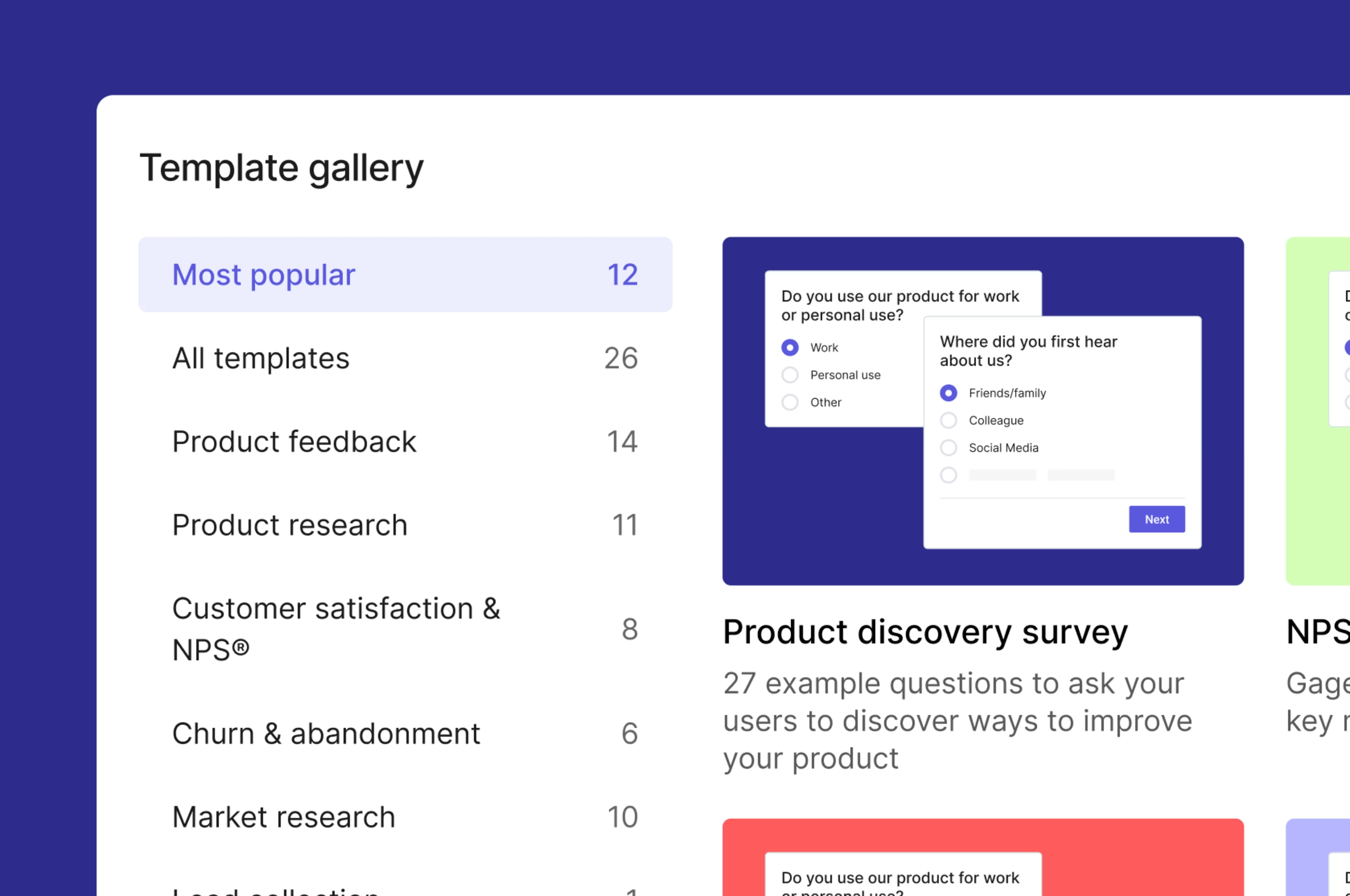An amazing customer experience begins with solid data. You've got to figure out what your customers need before you can deliver it—and you can capture this information with a few simple, straightforward customer experience (CX) surveys.
What is a CX survey?
A customer experience survey is a questionnaire designed to help a business capture customers’ thoughts and feelings about its brand, products, or services.
How is this relevant to your business? Think of it this way: a business is essentially a system with a purpose, where different elements (support staff, a sales platform, a clear marketing message, fulfillment, etc.) are interconnected to achieve an ultimate goal: satisfying your customers—and to give your customers a great experience, you need to know what they think is working (and isn't) across the whole system.
Customer surveys help you gather data at specific touch points (e.g. immediately after a sale, when a potential customer chooses to leave a website without purchasing, or after a customer support ticket gets resolved and closed), and acting on the customer experience insights you collect will help you improve the experience for both your current and future customers.
How to launch a CX survey in 4 steps
Setting up online surveys is pretty straightforward, but you’ll want to think about the big picture before you dive in: what you want to investigate will determine the type of survey questions you ask and where (in the customer journey) you ask them.
Step 1: determine what you want to study
Pick one touchpoint in the customer journey you want to study. Here are a few examples of things you could study at different stages in a typical ecommerce customer journey:
Pre-sale: do customers have enough information to make a purchase? Is anything stopping them from making a decision?
Post-sale: are they happy with the product post-purchase? Was the ordering process easy, or would they change something? Would they recommend you to a friend?
Following a support call: did you solve their pain point or problem? If so, how easy was it to find a solution? If not, how does that affect their opinion of your product and brand?
Downgrading, canceling, or returning an item: are they unhappy with the product or service? If so, why?
Step 2: pick the right survey
Different types of surveys will help you to determine whether your customers are happy, loyal, and satisfied, and each type can also help you learn something more about their experience. Let's run you through six of the most effective CX feedback surveys you can get started from.
Editor’s note: already know what survey to run and which questions to ask? Skip ahead to the templates below.
1. Customer Satisfaction (CSAT) score
CSAT surveys investigate the level of satisfaction a user experiences with your product/service; they often include a simple customer satisfaction survey question, such as “Are you happy with what you bought?,” with only two possible replies (e.g. yes/no, happy face/sad face).
Tracking your customer satisfaction score over time is very useful, because a sudden drop can quickly alert you to a pressing issue and the overall satisfaction score gives you a good idea if you’re successfully meeting customer expectations.
2. Net Promoter Score (NPS®)
![[Visual] NPS](http://images.ctfassets.net/gwbpo1m641r7/obOk6WuHi3X1yOc71De73/232ec64f77517471146b0281855cc9b6/Screenshot_2024-11-04_at_21.56.17.png?w=3840&q=100&fit=fill&fm=avif)
The Net Promoter Score® survey asks how likely someone is, on a scale of 0-10, to recommend your company/product to a colleague or a friend. It also allows you to ask ‘Why?’ with follow up questions, so you can compare your percentage of detractors (0-6 answers) to your percentage of promoters (9-10 answers), and have both a numerical benchmark for improvement and a qualitative list of elements that you need to fix to avoid churn.
NPS is the strongest predictor of a company’s future growth, so knowing the difference between a 'good' and a 'bad' NPS and reading about existing benchmarks is an important part of the process.
Net Promoter, Net Promoter System, Net Promoter Score_,_ NPS and the NPS_-related emoticons are registered trademarks of Bain & Company, Inc., Fred Reichheld and Satmetrix Systems, Inc._
3. Customer Effort Score (CES)
CES measures the effort it takes for customers to do things like fixing a problem through customer support or using your product in the first place.
You could send a CES survey each time you close a support ticket asking: “How easy was it to get your issue resolved?” The multiple-choice answer set could include a 5-point scale, with choices ranging from ‘very difficult’ to ‘very easy.’
Collect ongoing feedback
To supplement your CES survey, get in the habit of collecting ongoing feedback for real-time data and even more valuable insights about the overall customer experience.
Contentsquare’s Feedback Collection tool, for example, lets your users give in-context feedback throughout their journey so you can identify customer needs and paint points as they happen and address them in the moment.

4. Point-of-conversion survey
A point-of-conversion survey is sent out after customers reach a very specific milestone and complete a purchase on your site. They generally ask people to rate their buying experience on a scale (from 1 'hated it' to 5 'loved it'), and can include follow up questions that investigate what, if anything, almost stopped them from becoming a customer.
5. Exit-Intent Surveys

An exit-intent survey is great for finding out what prevents people from engaging with your site or brand. This survey is asked with a pop-up or on-screen question displayed as a user navigates to close the window.
Asking people about their reason for leaving helps you figure out what you need to do to improve conversions during checkout or on pricing and landing pages.
6. Retention survey
A retention survey investigates why customers are downgrading/canceling a service they subscribe to, or why they’re returning an item.
Retention surveys are usually included in the cancellation or return process. In addition to helping you investigate the main reason(s) people decided to leave your company or product, they can also help you understand the likelihood of customers returning to your business eventually.
Step 3: decide which types of questions to ask
When you look at our survey templates below, you’ll notice that each survey uses different types of questions. These questions weren’t chosen at random—each one serves a specific purpose, and each question type has its own advantages and disadvantages.
7 common survey questions types
The following are some of the most common types of questions you’ll find in digital customer experience surveys.
1. Open-ended questions
An open-ended question gives respondents the freedom to write anything they want. They’re ideal for identifying issues and opportunities you never knew existed because respondents aren’t limited by your multiple-choice options (see below).
The data is a touch more challenging to analyze, but there are lots of techniques to make analyzing open-ended questions easier.
Example: What could we improve about [product]?
2. Multiple-choice questions
Multiple-choice questions offer a limited number of possible answers. The survey results are easy to analyze, and survey response rates tend to be high because responding requires less effort than it does with open-ended questions (where users write a free-form response).
Multiple-choice questions include rating scale questions, binary scale questions, nominal questions, Likert scale questions, and semantic differential questions, which are all explained below.
3. Rating scale questions (also known as ordinal questions)
These questions offer a range of answers that correspond to a numeric scale, such as rating ease of purchase on a scale of 1-5. Be sure to define the scale well (e.g. 1: not easy at all, 5: very easy) so as not to cause confusion.
Example: How easy was your onboarding process? (1: not easy at all - 5: very easy)
4. Binary scale questions
These questions limit responses to one of two possibilities, such as ‘yes/no’, or ‘happy face/sad face’. A binary scale is less ambiguous than a rating scale, where one person’s 4-star experience might be another person’s 5-star experience.
Example: Did we solve your problem today? (yes/no)
5. Nominal questions
Nominal questions specify separate categories for answers. Answers don’t overlap (unless there’s an ‘all of the above’ option), and no numeric value is attached to the answers.
Example: Which of the following describes you? “I am ______”
A customer of [Company Name]
Not a customer, but thinking about becoming one
Not a customer and don’t plan to become one
6. Likert scale questions
The Likert scale is a 5- or 7-point scale used to evaluate customer sentiment. The smallest number (always a ‘1’) maps to one extreme perspective, while the highest number (e.g. a ‘7’ on a 7-point scale) maps to the opposite extreme. The middle number (e.g. a ‘4’ on a 7-point scale) indicates a more moderate view.
Example: To what extent do you agree with the following statement: [Product name]’s onboarding process was straightforward and easy.
1 - Strongly disagree
2 - Somewhat disagree
3 - Neither agree nor disagree
4 - Somewhat agree
5 - Strongly agree
7. Semantic differential questions
Similar to Likert scale questions in that they both use a 5- or 7-point scale, semantic differential questions don’t ask respondents to ‘agree’ or ‘disagree’ with a statement. Instead, they ask them to choose the point on the scale that best describes their position.
Example: How helpful do you find our knowledge base?
1 - Not helpful at all
2 - Barely helpful
3 - Neither helpful nor unhelpful
4 - Somewhat helpful
5 - Very helpful
Step 4: build and send your survey
When you are ready to build your survey, the specific steps you'll take will depend on the tool(s) you use.
If you use Contentsquare, you can take a tour of how to:
Regardless of your tool of choice, always keep the following three tips in mind:
Start small
You don’t need to set up a dozen surveys all at once: start small and see how it goes. If certain questions don’t work, consider tweaking or replacing/removing them (here is a list of 50+ survey questions to get you inspired). You’ll learn from your mistakes and improve with the next round.
Pick an ideal time to distribute your survey
Remember that timing matters when it comes to distributing surveys. For example, consider sending a customer service survey 20 or 30 minutes after the interaction, which gives the customer enough time to figure out whether the problem has been solved. Similarly, when you run a product NPS question, make sure that your customers have received your product and had sufficient time to use it first.
Evaluate your data (when your sample size is large enough)
Use a sample size calculator to figure out how many survey data points you need to achieve statistical significance (i.e. a representative sample of your customer base).
5 templates for great customer experience surveys
To start you off on the right foot, we’ve created five customer satisfaction survey templates for you to use directly in Contentsquare's Voice of Customer.

1. Net Promoter Score® (NPS) survey template
NPS is used to measure how likely your customers are to recommend you to friends or colleagues.
Who to ask: paying customers who have had some time to experience your product(s).
When to use it: wait until customers have had a chance to experience your product and brand.
Where to ask: ecommerce companies can send via email (since return visits aren’t guaranteed). SaaS companies can use pop-ups, on-page polls, or send via email.
2. Customer Satisfaction (CSAT) survey template
CSAT questions typically require a binary answer (yes/no, good/bad), and they’re used to determine whether customers are satisfied with their experience.
Who to ask: anyone (prospects, customers, people who have just used support, etc.).
When to use it: following any website interaction you want to evaluate.
Where to ask: on-page survey or via email.
Note: when following up on a customer support call, delay 20-30 minutes so customers can evaluate whether support fixed the issue.
3. Customer Effort Score (CES) survey template
CES measures the effort it takes for customers to accomplish something (e.g. fix a problem, place an order).
Who to ask: customers attempting to achieve a goal on your website.
When to use it: 20-30 minutes after a support call (so they have time to evaluate).
Where to ask: on-page survey or via email.
4. Point-of-conversion survey template
What is it? The point-of-conversion survey measures how satisfied customers are with the buying experience.
Who to ask: customers.
When to use it: immediately following the sale.
Where to ask: on-page survey.
5. Retention survey template
The customer retention survey asks clients why they are downgrading, canceling, or returning an item.
Who to ask: clients who are downgrading or canceling their membership (on subscription services), and clients who are returning an item (on ecommerce websites).
When to use it: during the cancellation or return process.
Where to ask: on-page survey.
![How to Improve CX With Surveys [Steps, Examples, & Strategy] — Cover Image](http://images.ctfassets.net/gwbpo1m641r7/3IQ0IahJEOnhmLEFZKLXf4/d46b6ce27b48ba33b4a256e13d2aa05b/Customer-Segmentation-Analysis.jpg?w=3840&q=100&fit=fill&fm=avif)
![[Visual] Contentsquare's Content Team](http://images.ctfassets.net/gwbpo1m641r7/3IVEUbRzFIoC9mf5EJ2qHY/f25ccd2131dfd63f5c63b5b92cc4ba20/Copy_of_Copy_of_BLOG-icp-8117438.jpeg?w=1920&q=100&fit=fill&fm=avif)